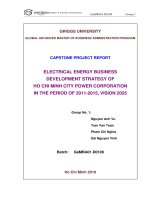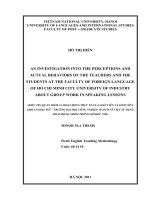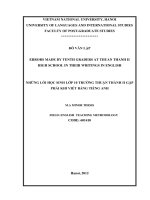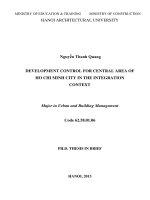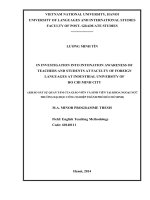the effects of mind mapping on 11th graders’ reading comprehension at le thanh ton high school in district 7 of ho chi minh city
Bạn đang xem bản rút gọn của tài liệu. Xem và tải ngay bản đầy đủ của tài liệu tại đây (1.92 MB, 122 trang )
MINISTRY OF EDUCATION AND TRAINING
HO CHI MINH CITY OPEN UNIVERSITY
_________________________
NGUYEN THI MY CHAU
THE EFFECTS OF MIND MAPPING ON 11TH
GRADERS’ READING COMPREHENSION AT LE
THANH TON
HIGH SCHOOL IN DISTRICT 7 OF
HO CHI MINH CITY
MASTER OF ARTS IN TESOL
Ho Chi Minh City, 2019
MINISTRY OF EDUCATION AND TRAINING
HO CHI MINH CITY OPEN UNIVERSITY
NGUYEN THI MY CHAU
THE EFFECTS OF MIND MAPPING ON 11TH
GRADERS’ READING COMPREHENSION AT LE
THANH TON
HIGH SCHOOL IN DISTRICT 7 OF
HO CHI MINH CITY
MAJOR: TEACHING ENGLISH TO SPEAKERS OF OTHER LANGUAGE
CODE: 60 14 01 11
MASTER OF ARTS IN TESOL
Supervisor : Assoc. Prof. Dr. NGUYEN THANH TUNG
Ho Chi Minh City, 2019
STATEMENT OF AUTHORSHIP
I certify that this thesis entitled “The Effects of Mind Mapping on 11th Graders‟
Reading Comprehension at Le Thanh Ton High School in District 7 of Ho Chi
Minh City” is my own work.
Except where reference is made in the text of the thesis, this thesis does not contain
material published elsewhere or extracted in whole or in part from a thesis by which
I have qualified for or been awarded another degree or diploma.
No other person‟s work has been used without due acknowledgement in the main
text of the thesis. This thesis has not been submitted for the award of any degree or
diploma in any other tertiary institution.
Ho Chi Minh City, 2019
NGUYEN THI MY CHAU
i
ACKNOWLEDGEMENTS
This Master of Arts in TESOL thesis is the result of a fruitful collaboration of all
the people who have kindly contributed with enormous commitment and
enthusiasm in my research. Without the help of those who supported me at all times
and in all possible ways, it would not have been feasible for me to complete my
M.A. thesis.
First of all, I am deeply indebted to my supervisor, Assoc. Prof. Dr. Nguyen Thanh
Tung, from Ho Chi Minh City University of Education, whose compassion,
encouragement and guidance throughout the research have helped in the completion
of this thesis. I have truly learned from the excellence of his skills and from his
wide experience in research; no words are adequate to describe the extent of my
gratitude.
I am also sincerely grateful to all lecturers of the Open University in Ho Chi Minh
City for providing me with invaluable sources of intellectual knowledge during my
study there. This knowledge was very useful when I conducted this research.
I owe a great debt of gratitude to the anonymous participants who contributed data
to this thesis. Without them the data collection for this study could not properly
been carried out.
Last but not least, I would like to express my particular gratitude to my beloved
husband and my family for their unconditional love, understanding, encouragement,
financial and spiritual support over time and distance.
ii
ABSTRACT
Reading comprehension is significantly important for students at all levels as it can
help them enhance their foreign language learning. However, teaching reading has
not been concerned appropriately at many high schools in Vietnam and this is also
true to Le Thanh Ton High School, at which the teaching approach has been
focused on the product rather than the process of learning and limited the students‟
involvement. A mind mapping strategy is believed to exert a positive effect on
improving students‟ comprehension and motivating them to read. Therefore, the
study aimed at investigating the feasibility of using mind mapping as a strategy in
teaching reading comprehension to Vietnamese high school students, particularly
those at Le Thanh Ton High School in District 7 of Ho Chi Minh City.
To achieve this purpose, relevant literature on mind mapping including types,
benefits, time, and situations of using it was reviewed in the theory chapter to shape
the theoretical framework of the study.
Based on this conceptual framework, the study was conducted Le Thanh Ton High
School with the participation of 80 11th graders. Data were collected through the
tools of a pre-test, a post-test, a questionnaire, and interviewing, and then analyzed
with version 20.0 of the SPSS software.
The findings of the study indicate that mind mapping technique enhanced the
participants‟ reading performance and increased their positive attitudes towards
reading learning.
Based on the research findings, the paper concluded with some pedagogical
implications and a recommendation for further study in the line of research on mind
mapping.
iii
TABLE OF CONTENTS
STATEMENT OF AUTHORSHIP .................................................................................... i
ACKNOWLEDGEMENTS ............................................................................................... ii
ABSTRACT ........................................................................................................................ iii
TABLE OF CONTENTS .................................................................................................. iv
LIST OF FIGURES ......................................................................................................... viii
LIST OF CHARTS ............................................................................................................ ix
LIST OF TABLES .............................................................................................................. x
CHAPTER 1 : INTRODUCTION..................................................................................... 1
1.1. Background of the study ............................................................................................ 1
1.2. Statement of the problem ........................................................................................... 2
1.3. Rationale to using mind mapping .............................................................................. 3
1.4. Aim of the study and research questions .................................................................... 4
1.5. Significance of the study ............................................................................................ 4
1.6. Organization of the study ........................................................................................... 4
CHAPTER 2 : LITERATURE REVIEW ........................................................................ 6
2.1. The understanding of mind mapping ......................................................................... 6
2.1.1. Definition ............................................................................................................ 6
2.1.2. Types ................................................................................................................... 8
2.2. Reading comprehension ........................................................................................... 12
2.2.1. Definition .......................................................................................................... 12
2.2.2. Approaches ........................................................................................................ 12
2.3. The learners of reading comprehension class with mind mapping .......................... 14
2.4. The use of mind mapping inside and outside of the classroom ............................... 15
2.5. The use of mind mapping in stages of teaching reading comprehension................. 15
2.6. Relationship of mind mapping to reading comprehension....................................... 17
2.6.1. Enhancing reading comprehension ................................................................... 17
iv
2.6.2. Enhancing learning motivation ......................................................................... 18
2.7. Procedure to apply mind mapping in teaching reading comprehension class.......... 18
2.8. Previous studies related to the research topic........................................................... 19
2.9. Chapter summary ..................................................................................................... 21
CHAPTER 3: METHODOLOGY .................................................................................. 22
3.1. Research site ............................................................................................................. 22
3.2. Research participants................................................................................................ 22
3.3. Approach and method of investigation .................................................................... 24
3.3.1. Approach ........................................................................................................... 24
3.3.2. Methodology ..................................................................................................... 24
3.3.3 Techniques of data collection ............................................................................. 27
3.3.3.1. Pre-test and post-test ...................................................................................... 27
3.3.3.2. Questionnaire ................................................................................................. 28
3.3.3.3. Interview ......................................................................................................... 29
3.4. Analytical framework ............................................................................................... 31
3.4.1. Tests .................................................................................................................. 31
3.4.1.1. Grouping individual scores ............................................................................ 31
3.4.1.2. Comparing means .......................................................................................... 32
3.4.1.3. Checking assumptions of the Independent samples t-test .............................. 32
3.4.2. Questionnaire .................................................................................................... 33
3.4.3. Interview ............................................................................................................ 33
3.5. Reliability and validity ............................................................................................. 34
3.5.1. Tests .................................................................................................................. 34
3.5.2. Questionnaire .................................................................................................... 35
3.5.3. Interview ............................................................................................................ 35
3.6. Summary .................................................................................................................. 35
CHAPTER 4: DATA ANALYSIS AND DISCUSSION ................................................ 36
4.1. Data analysis ............................................................................................................ 36
v
4.1.1. Results in the tests ............................................................................................. 36
4.1.1.1. Performance of the both groups on the pre-test ............................................. 36
4.1.1.2. Performance of the both groups on the post-test ........................................... 39
4.1.1.3. Summary of test results .................................................................................. 43
4.1.2. Results in the questionnaire............................................................................... 43
4.1.2.1. Reliability of the questionnaire ...................................................................... 43
4.1.2.2. Students’ perceptions on the effects of mind mapping on reading
comprehension ............................................................................................... 44
4.1.2.3. Students’ perceptions on the effects of mind mapping on reading motivation46
4.1.2.4. Students’ perceptions on the challenges of applying mind mapping for
reading ........................................................................................................... 47
4.1.2.5. Summary of students’ perceptions .................................................................. 49
4.1.3. Results in the interview ..................................................................................... 49
4.2. Discussion ................................................................................................................ 53
4.2.1. The students‟ improvement of reading comprehension with mind mapping .... 53
4.2.2. The students‟ positive change in learning attitudes with mind mapping .......... 55
4.3. Chapter summary ..................................................................................................... 57
CHAPTER 5: CONCLUSIONS AND RECOMMENDATIONS ................................. 58
5.1. Conclusion of key findings ...................................................................................... 58
5.2. Evaluation of methodology ...................................................................................... 59
5.2.1. Strengths ............................................................................................................ 59
5.2.2. Limitations ........................................................................................................ 59
5.3. Recommendations .................................................................................................... 60
5.3.1. For teachers ....................................................................................................... 60
5.3.2. For students ....................................................................................................... 61
5.4. Suggestions for further research ............................................................................... 61
5.5. Chapter summary ..................................................................................................... 61
REFERENCES.................................................................................................................. 62
vi
APPENDIX A .................................................................................................................... 70
APPENDIX B.1 ................................................................................................................. 74
APPENDIX B.2 ................................................................................................................. 80
APPENDIX B.3 ................................................................................................................. 85
APPENDIX C .................................................................................................................... 89
APPENDIX D .................................................................................................................... 94
APPENDIX E.1 ............................................................................................................... 100
APPENDIX E.2 ............................................................................................................... 103
APPENDIX F .................................................................................................................. 105
APPENDIX G .................................................................................................................. 106
APPENDIX H .................................................................................................................. 107
vii
LIST OF FIGURES
Figure 2.1: Example of a mind map (Buzan, 2011)..........................................................8
Figure 2.2: An example of Network Tree Map ................................................................9
Figure 2.3: An example of Event Chain Map .................................................................10
Figure 2.4: An example of Cycle Concept Map .............................................................10
Figure 2.5: An example of Spider Concept Map ............................................................11
viii
LIST OF CHARTS
Chart 4.1: Pre-test score distribution of the experimental and control groups…………….36
Chart 4.2: Post-test score distribution of the experimental and control groups…….……..40
ix
LIST OF TABLES
Table 3.1. Demographic information of the participants .................................................... 23
Table 3.2. The types of mind mapping of each unit ............................................................ 25
Table 4.1. Group statistics on the pre-test of the experimental and control groups ............ 37
Table 4.2. Independent Samples T-test on the pre-test of the two groups ........................... 38
Table 4.3. Tests for normality of pre-test scores ................................................................. 39
Table 4.4. Group statistics on the post-test of the experimental and control groups ........... 41
Table 4.5. Independent Samples T-test on the post-test of the two groups ......................... 41
Table 4.6. Tests for normality of post-test scores ................................................................ 42
Table 4.7. Reliability of the Questionnaire (Items 1-20) .................................................... 43
Table 4.8. Students' perceptions on the effects of mind mapping on reading ..................... 44
Table 4.9. Students' perceptions on the effects of mind mapping on reading motivation .. 46
Table 4.10. Students' perceptions on the effects of mind mapping on challenges of applying
mind mapping for reading.................................................................................................... 48
Table 4.11 Interview results................................................................................................. 50
x
CHAPTER 1 : INTRODUCTION
1.1. Background of the study
Learning English is very important and essential in an increasingly globalized
world. Every year, millions of immigrants from non-English speaking countries travel
around the world, showing that learning to communicate in English is one of the most
important elements to enable them to survive in these English speaking countries.
Working with knowledge of the English language creates many opportunities in
international workplaces.
In order to master English, learners need to develop all four skills of reading,
speaking, listening, and writing. Relatively all humans learn to talk before reading;
however, as soon as children reach middle school, they learn how to read first. That is the
reason why reading is the common instrument for students to focus on first. Another
reason to show reading is ranked first is that considerable printed materials are available
for students. This means students tend to face written text very commonly as well as read
a lot. Moreover, reading may be the foundation of other skills since it offers a wide range
of interesting information and of a language structures which are vital for developing
other language skills. Although both reading and listening are both receptive skills,
reading can easily trigger the reader‟s memory through his/her eyes while remembering
through listening requires more efforts. In addition, when children are all taught to read
out loud, the words they vocalize are remembered together with its meaning. Reading
also builds concentration in young children.
In fact, mastering reading skill is not easy because reading is a complex process to
learn and teach (Carnine, Silbert & Kameenui, 1990). In fact, the essential component in
reading process is comprehension and comprehending successfully compels readers to
spend a long and difficult learning period, which means they encounter many problems.
According to McNamara (2009), teaching reading strategies is one of the most effective
means which help students to tackle the problems; therefore, teachers need to consider
1
teaching students reading strategies which help them to overcome the breakdown in
reading process. By this way, students can read effectively as well as enhance their
comprehension competence.
Actually, there are many strategies which can help the teacher use to solve their
students‟ troubles in reading. Mind mapping can be considered as an alternative
technique in teaching reading comprehension (Rizqiya, 2013; Winanda, 2015). Suherman
(2015) says that using mind mapping technique contributes to the improvement of
students‟ skill and the increase in their motivation in reading a text. That is students can
enhance their reading skills and become more interested in reading.
In Vietnam, some researchers have applied mind mapping for teaching and learning
recently. Le Nguyen Huong Giang (2009) and Do Nguyen Xuan Thao (2015) proved that
mind mapping is a feasible strategy to enhance learners‟ vocabulary. In their studies, Le
Thai Hung (2008), Nguyen Thi Phuoc Binh (2011), Huynh Thi Thai Hoa (2012), and
Luong Thi Bach Tuyet (2015) found that the mind mapping strategy had positive effects
on improving readers‟ comprehension as well as motivating them to read. These studies
showed that mind mapping is still used with limitation in teaching English in Vietnam.
1.2. Statement of the problem
According to Carrell (1984), reading is the most important skills of the four macro
skills; however, teaching reading has not been concerned appropriately at many high
schools in Vietnam and this is also true to Le Thanh Ton High School. In fact, the
process of teaching and learning reading comprehension at this school is still
implemented in conventional ways in which the teacher mainly asks students to do the
task in textbook without checking their achievement after reading the text. The practice
of strategic reading instruction has profoundly governed by the traditional approach (i.e.
Grammar-Translation Method) in which teachers and tasks in the instructional materials
are vital centers while students turn out passive in their reading process, and both
teachers and students are strictly bound by the prescribed curricular (Le, 2010). In
2
particular, these activities usually ask students to respond to a worksheet or to answer a
list of comprehension questions without making sure all students can comprehend the
information in the passage. Sometimes teachers translate the text into Vietnamese without
students‟ contribution. This teaching approach focuses on the product rather than on the
process of learning and limits students‟ involvement. In general, teaching students
reading strategies to complete these reading tasks seems to be disregarded in Vietnamese
high school classes (Nguyen & Trinh, 2011). It is opposite to the purpose of reading
strategy which is to develop their comprehension skills. Thus, it is necessary to add an
alternative reading-teaching technique in order to provide students with instructional
activities in understanding texts effectively.
1.3. Rationale to using mind mapping
Mind maps are visual frameworks such as figures, diagrams, or charts used to
present structural knowledge spatially with the intention of empowering comprehension
and learning (Siriphanich & Laohawiriyanon, 2010). Mind maps are effective in terms of
helping decode information because they can clarify complex concepts into simple,
meaningful displays so that learners can develop a holistic understanding of the content
to be learnt. Teachers may use mind mapping technique at different stages of instruction
for example during instruction to prepare students to approach new information and
clarify complex ideas, or after instruction to assess and reinforce learning and instruction
(Bekti, 2009). Generally speaking, teaching reading skill by using mind mapping actually
is not a new issue in language pedagogy. Mind mapping technique has been applied in
many studies. As mentioned earlier, although mind mapping may contribute to the
development of students‟ reading comprehension and motivation, this technique seems to
be scantily done in the Vietnamese context. In order to investigate the feasibility of using
mind mapping as a strategy in teaching reading comprehension for Vietnamese high
school students, particularly those at Le Thanh Ton High School in District 7 of Ho Chi
Minh City, the researcher is going to conduct this study.
3
1.4. Aim of the study and research questions
Purposely, this study aims to examine the effects of mind mapping on students‟
reading comprehension ability and their attitudes towards learning English reading skills
with it. The two research questions below have been designed with the purpose to
achieve the research objectives:
1. To what extent does mind mapping improve students’ reading comprehension
ability?
2. What are their attitudes towards the use of mind mapping in their reading
comprehension learning?
1.5. Significance of the study
If the study is successful, it will add one more technique that can help high school
students, especially those of grade 11, overcome their troubles in learning reading skill.
Moreover, learners might be interested in reading comprehension and improve their
reading skills as well. The activities of brainstorming, organizing and constructing a mind
map may help to upgrade students‟ reading ability. Furthermore, inferring from the
students‟ feedback, the researcher will have more experience to plan the lesson with the
application of mind mapping and share with other teachers.
1.6. Organization of the study
Chapter 1 introduces the study by presenting its background, statement of the
problem, purpose, research questions, significance, and structure. Chapter 2 comprises
definitions and types of mind mapping, relationship of mind mapping to reading
comprehension ability, stages and procedures to applying mind mapping in reading
comprehension class, as well as some previous studies. Chapter 3 describes research site,
participants, research design, and method of investigation, analytical framework, and
validity and reliability. Chapter 4 provides a presentation of data analysis and discussion
4
of the findings obtained from the three tools of tests, questionnaires and interviews.
Finally, Chapter 5 involves the main findings of the study, the limitations, and
suggestions for further research.
5
CHAPTER 2 : LITERATURE REVIEW
In order to use the mind mapping technique in teaching language effectively, it is
necessary to work out its theoretical background. Thus, this part is going to present
definitions and types of mind mapping, relationship of mind mapping to reading
comprehension ability, stages, and procedures to applying mind mapping in reading
comprehension class. After that, some previous studies which are relevant to the
investigative topic will also be included in this part.
2.1. The understanding of mind mapping
2.1.1. Definition
A mind map was firstly introduced by Buzan, T. in the late 1960s. There are
various ways to mention a mind map from Buzan. For instance, according to Buzan
(1984), the feature of mind maps is an intimately linked to the operation of the mind, and
these mind maps can be applied in nearly every activity including taking notes when
summarizing the reading texts. Buzan, T. and Buzan, B. (2000) draw out that a mind map
as a skeleton in which ideas and pictures are produced from a concept. They depict a
mind map as a visual-spatial map which consists of from five to ten main ideas bounding
and relating to the central word or concept. During a long time of re-perceiving,
according to Buzan (2006), a mind map is a graphic method of storing, organizing
information. It can be inferred that the first characteristic of mind mapping is to help
learners store, organize, and remember information, which is in association with notetaking or summarizing reading texts.
In addition, Kaufman (2008) defines a mind map is a non-linear diagram to grasp
key information and linkages between ideas. It means that the idea will be started in the
central point to connect the minor content. Then the branches capturing more detailed
information related to the key ideas scatter away from the thoughts in the center.
6
Therefore, the second trait of a mind map is that it is a network of many related specific
ideas bounding a centric concept.
A mind map is a diagram while mind mapping is a technique. According to
Trianto (2009), mind mapping is a graphic illustration revealing how a single concept
relates to other concepts in the same categories. It is a note-taking method making us to
remember much information (De Porter, Readon, & Nourie, 1999). Thus, the third trait of
a mind map is generally viewed as colorfully drawn by creative symbols or images.
In fact, there are the connections between the ideas and concepts which mindmapping presents by lines, colors, arrows, images, and pictures, motivating the brain and
allowing individuals to visualize related ideas. It is a visual tool that can be used to
generate ideas, take notes and organize thinking (Murley, 2007). In other words, it is a
tool that helps learners to get an effective study technique in applying it to read the
written materials (Farrand, Hussain, & Hennessy, 2002). All in all, the last attribute of a
mind map is that the connections between ideas or concepts are illustrated by lines or
arrows.
Based on what mind mapping or a mind map has been extensively defined, it can
be concluded that mind mapping is a technique in conjunction with note-taking or
summarizing reading texts in many cases, and can be used to visualize a network of many
related specific ideas bounding a centric concept within lines or arrows, symbols and
images. Figure 2.1 below is a typical example of a mind map.
7
Figure 2.1: Example of a mind map (Buzan, 2011)
2.1.2. Types
The classification of mind mapping depends on the purpose that the user would
like to capture. According to Trianto (2009), mind mapping can be network tree map,
event chain map, cycle concept map, or spider concept map.
The first type is Network Tree Map, in which the main ideas are made in a
quadrangle and other words written in the line. It is suitable for visualizing a cause and
effect relation, and technical terms are used to explain the correlations.
8
Ecosystem component
Abiotic
Biotic
Producer
Decomposer
Consist of
based on the function
Consumer
Herbivore
Based on
Omnivore
types of food
Example
Example
Example
Carnivore
Water,
sunlight
Rabbit
Example
Monkey
Tiger
Figure 2.2: An example of Network Tree Map
9
The second type is Event Chain Map. The event chain can be used for giving steps
in a procedure, which is illustrated as follows:
Ecosystem component
Ecosystem component
Ecosystem component
Ecosystem component
Figure 2.3: An example of Event Chain Map
Next, Cycle Concept Map is suitable to show a correlation how a combination
accident is interacting to produce a group of result repeatedly.
Evapora-tion
water
water steam
Condensation
Figure 2.4: An example of Cycle Concept Map
Finally, the Spider Concept Map is suitable to visualize something which is not
based on hierarchy, a category which is not parallel, and result of sharing opinion, which
is illustrated as follows:
10
Water
Biology
Land
Physic
Air
Chemistry
Sound
Pollution
Reforestation
Thinning of ozone
Acid rain
Recycle
Global warming
Figure 2.5: An example of Spider Concept Map
Generally speaking, mind mapping can help to tackle the shortage of students‟
vocabulary in memorizing some words from the reading passages. Mind mapping can
assist the students to grasp key information and linkages among ideas of the given texts.
From that, readers can reinforce their reading comprehension. In order to serve the
purpose of this study, the following types of maps are going to be discussed: Network
Tree Map, Event Chain Map and Spider Concept Map. They represent three different
structures and diagrams to link ideas of a reading text together. Especially, these three
kinds of mind map are highly suitable to the content of the units of English 11 at high
school.
11
2.2. Reading comprehension
2.2.1. Definition
Reading comprehension is an interactive course of decoding both the surface and
hidden meanings of a text (Rumelhart, 1994); it is a complex cognitive capacity requiring
the ability to combine text information with the background knowledge of the reader
(Meneghetti, Carretti, & Beni, 2006). In short, reading comprehension refers to the ability
to understand a text requires a reasonable knowledge of basic grammar, an ability to
identify main ideas in the text, an awareness of discourse structure, and strategic
processing with more difficult texts (Grabe, 2009).
2.2.2. Approaches
It is noted that in an attempt to understand the definitions of reading skill and
comprehension, several researchers have proceeded by analyzing it in terms of a set of
approaches to reading process which will be presented as below. Many researchers in the
field of reading have classified the models of reading into three categories such as
bottom-up, top-down, and interactive approaches. These approaches describe what
happens when readers look at the text, and also what complementary ways of processing
a text are. Readers use them with unconscious way, or adopt them as conscious processes
during reading a text.
2.2.2.1. Bottom-up
Bottom-up processing is considered as a process which is related to language
structures. To put it another way, it concentrates on individual words, phrases or cohesive
devices and gets understanding by associating detailed elements together to create a
whole (Grabe, 2009). In the bottom-up approach, the role of word knowledge is requisite
for lexical recognition which is regarded as its strength. On the other hand, bottom-up
processing is also hierarchical, through identifying letters and words and constructing a
meaning for a written text from the smallest textual units at the “bottom” (i.e. letters and
12
words) to bigger units at the “top” (i.e. phrase, clause, and sentential linkages). Therefore,
the knowledge of vocabulary is a fundamental advantage for this process.
2.2.2.2. Top-down approach
Top-down processing is a model by which the readers get a general view of the
reading passage and absorb the overall picture. In specific, the readers base on their
background knowledge and expectations to reconstruct the meaning of the text. One
important advantage of this process is language knowledge, world knowledge and
personal experiences are expressed in top-down influences reading comprehension
(Anderson, 1991). In summary, the top-down model of reading focuses on meaning.
Cohen (1990) explains that the readers should not recognize all letters, words and
sentences in the written text; instead of that, they only need to identify key words and
phrases to comprehend the meaning of the text. It is started with predictions and then
some attempt to check these predictions by working down the written texts. Thus, it is
more useful for readers to make a combination between top-down and bottom-up
processing to achieve the best in reading comprehension.
2.2.2.3. Interactive approach
From the problems emerging in bottom-up and top-down processing, many
researchers found that interactive models appears to provide a better result of reading
performance than heavily rely on bottom-up or top-down model. The interactive model
involves employing both top-down and bottom-up skills to construct the meaning of the
text. It highlights that reading is the interaction between readers and texts (Grabe, 2009).
In short, the interactive approach emphasizes the application to the interaction of bottomup and top-down processes to get successful reading, it is necessary for readers to have an
appropriate balance between these approaches. In other words, an inappropriate balance
between bottom-up and top-down models leads to failure in reading comprehension,
thereby producing unsuccessful readers.
13



